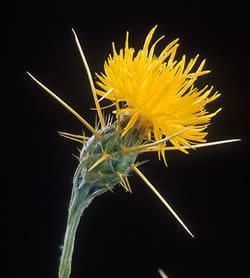By Michele Carter, Butte County Master Gardener, July 12, 2013

Yellow starthistle seeds germinate from fall through spring, corresponding to the normal rainy season in California. After germinating, the plant allocates most of its resources to root growth and by late spring, roots can extend over 3 feet. The plant exists as a short rosette amongst other weeds until it begins to flower.
The foliage of this plant ranges from gray-green to blue-green; once flowering begins it can easily be identified by its bright, thistle-like yellow flowers, which have sharp spines surrounding their bases. This weed grows from 6 inches to up to 5 feet.
Yellow starthistle forms dense infestations and rapidly depletes soil moisture, preventing the establishment of other species. It is also poisonous to horses, causing a nervous disorder called “chewing disease” (nigropallidal encephalomalacia), which is fatal once symptoms develop. Horses are the only animal known to be affected – they should not be allowed to graze on yellow starthistle.

Yellow starthistle can be spread as a contaminant in grass seed and in all classes of hay, particularly grass hay. Hay used as mulch along roadsides or disturbed areas can be a source of yellow starthistle. Livestock that have fed in areas infested with yellow starthistle can be transporters of the seed.
Because the seeds germinate during the rainy season, a single cultivation after the rainy season, when soils are dry, effectively controls yellow starthistle seedlings and rosettes. Timing is critical: this cultivation must take place in late spring after the last rains but before seeds are produced.
Mowing can be used to manage starthistle. Be sure to mow well before starthistle is in full flower or has set seed. Mowing is most effective when soil moisture is low and no irrigation or rainfall follows mowing. If rain occurs after you've removed existing plants, seeds will continue to germinate and the eradication process must be repeated. Pre-emergent and post-emergent herbicides can also be helpful in controlling growth and infestation of starthistle.
Lastly, effective management of starthistle includes revegetation. Planting affected areas with desirable plants discourages starthistle regrowth by creating competition.
For information about herbicides and for photos of yellow starthistle's growth cycle, visit http://www.ipm.ucdavis.edu/PMG/PESTNOTES/pn7402.html